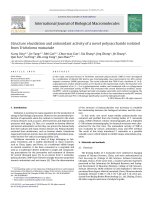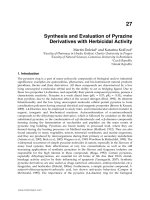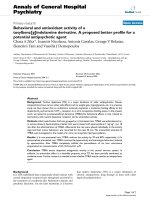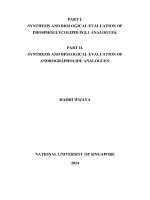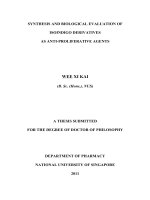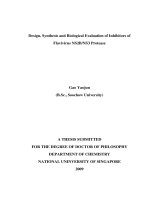Synthesis and evaluation of acetylcholineesterase inhibitory potential and antioxidant activity of benzothiazine derivatives
Bạn đang xem bản rút gọn của tài liệu. Xem và tải ngay bản đầy đủ của tài liệu tại đây (225.5 KB, 9 trang )
Turkish Journal of Chemistry
/>
Research Article
Turk J Chem
(2013) 37: 262 – 270
ă ITAK
c TUB
doi:10.3906/kim-1207-67
Synthesis and evaluation of acetylcholineesterase inhibitory potential and
antioxidant activity of benzothiazine derivatives
Durre SHAHWAR,∗ Uzma SANA, Naeem AHMAD
Research Lab. II, Department of Chemistry, Government College University, Lahore-54000, Pakistan
Received: 28.07.2012
•
Accepted: 31.01.2013
•
Published Online: 17.04.2013
•
Printed: 13.05.2013
Abstract: The aim of the present study was to synthesize and characterize benzothiazine derivatives prepared by using
2-aminothiophenol and saccharine and in vitro screen their enzyme inhibition and antioxidant potential. Nine different
derivatives were prepared and their structures were confirmed by spectral studies (EIMS, 1 H and
13
C NMR). Enzyme
inhibition potential of the synthesized compounds was evaluated by Ellman’s method, while antioxidant activity was
determined by DPPH and FRAP assays. All the derivatives showed remarkable activity against acetylcholine esterase
with IC 50 values in the range of 35.9–122.0 μ M. All other derivatives, except compound 4a, were inactive towards
DPPH radical. The results of the FRAP assay showed significant reducing potential of compounds 1, 2, 2a, and 4a.
Key words: Acetylcholine esterase, benzothiazine, DPPH, FRAP
1. Introduction
Acetylcholinesterase (AChE) catalyzes hydrolysis of the neurotransmitter acetylcholine, which results in the
termination of the nerve impulse in cholinergic synapse, and consequently induces several neurological disorders
such as Alzheimer disease (AD) and Parkinson disease. 1 AChE inhibitors are the most effective approach to treat
the cognitive symptoms of AD and other possible therapeutic applications in the treatment of Parkinson disease,
senile dementia, and ataxia, among others. 2 Inhibition of AChE increases the neurotransmitters in the synaptic
cleft and results in a positive cognitive effect in AD patients. 3 Acetylcholine acts as principle neurotransmitter in
the central and peripheral nervous system; it plays a role in the transformation of information between a neuron
and its adjacent cells (synaps). 4 AChE inhibitors such as tacrine, donepezil, rivastigmine, and galanthamine are
the only drugs currently approved for the treatment of AD. However, due to their short half-lives or unfavorable
side effects these drugs are known to have limitations for clinical use. 5
Free radicals are implicated in oxidative stress reactions, which can damage cells and tissues and cause
disorders in the immune system resulting in cancer, aging, and cardiovascular and neurodegenerative diseases. 6
Antioxidants, therefore, play an important role in disease prevention and health maintenance. To this extent,
there is an increasing role of free radical mediated damage in human disease etiology. 7−9 Due to several side
effects associated with the already available antioxidants and drugs for AD, there is a need for more selective
and potent drugs.
Previous studies of the enzyme inhibition activity of benzothiazines indicated a very good binding affinity
of these compounds towards cyclooxygenases that possess 2 active sites. Acetylcholine esterase also comprises
∗ Correspondence:
262
SHAHWAR et al./Turk J Chem
2 active sites, an anionic subsite that binds with the quaternary amine of acetylcholine and an esteratic subsite
where acetylcholine is hydrolyzed. We prepared various derivatives of benzothiazines to evaluate the binding
affinity of these compounds towards the active sites of acetylcholine esterase. For future studies we propose
docking calculations and superimposition of the best molecules with the co-crystallized ligand in the active site
of AChE.
Benzothiazine derivatives have pronounced importance in pharmaceutical chemistry and organic synthesis. Many of these derivatives have been reported to possess a wide range of biological activities such as
antibiotic, anticancer, antiviral, antifungal, antimicrobial, and antiparkinson properties. 10 Other studies on benzothiazines derivatives indicate that they possess antipyretic and analgesic activities higher than aspirin. 11,12
Studies of the structure–activity relationship of benzothiazine derivatives reveal that changing the structure
of the substituent group commonly results in a change in its bioactivity. Substitution of the hydroxy group
in benzothiazine derivatives enhances the effectiveness of these compounds against AD, acute neurodegenerative disorders, Pick disease, epilepsy, and ischemia. 13 Since modifications in basic structures cause changes
in compound strength and can lead to the synthesis of many biologically active analogues, the present study
was designed to synthesize 1,2- and 1,4-substituted benzothiazine derivatives that possess interesting biological
activities. 14
2. Materials and methods
2.1. Chemicals and instruments
All the chemicals and reagents used in the synthesis were purchased from Merck (Germany) and Panreac (Spain).
The reactions were monitored by TLC using pre-coated silica gel cards. Infrared spectra were recorded as KBr
disks using a PerkinElmer 735B infrared spectrophotometer. EI mass spectrometry was carried out using a MAT
312 instrument. 1 H NMR and 13 C NMR samples were prepared in CD 3 OD containing TMS as an internal
standard and spectra were recorded at 400 MHz and 100 MHz respectively using a Bruker Avance spectrometer.
Folin–Ciocalteu (FC) reagent, DPPH, butylated hydroxy toluene (BHT), acetylthiocholine iodide, and 5,5 dithiobis [2-nitrobenzoic acid] (DTNB) were purchased from Sigma (St. Louis, MO, USA), while erythrocytes
(acetylcholine esterase) were obtained from the Biochemistry Lab, Mayo Hospital, Lahore.
2.2. Preparation of benzothiazine derivatives
2H -1,4-Benzothiazine-2, 3(4H )-dione (1): 1.07 mL (0.01 mol) of 2-aminothiophenol and 1.26 g (0.01 mol)
of oxalic acid were refluxed for 2 h in 5 mL of xylene. The yellow precipitates obtained were filtered, dried, and
recrystallized in methanol (mp = 180 ◦ C, 65% yield).
Ethyl 3-oxo-3,4-dihydro-2H -1,4-benzothiazine-2-carboxylate (2): 15.2 mL (0.1 mol) of diethylmalonate and 10.8 mL (0.1 mol) of 2-aminothiophenol were taken in a 50-mL round bottom flask and refluxed
for 1.5 h. The reaction was monitored with the help of TLC n-hexane and ethyl acetate (1:1). After the completion of the reaction, the precipitates were filtered, washed with distilled water, and dried. Recrystallization
in methanol yielded yellow needle-like crystals (mp = 86 ◦ C, 53% yield). 15
Ethyl 4-methyl-3-oxo-3,4-dihydro-2H-1,4-benzothiazine-2-carboxylate (2a): 0.24 g (0.001 mol)
of compound 2, 5 mL of acetone, and 0.4 mL of 20% sodium hydroxide solution were taken in a round bottom
flask. The reaction mixture was stirred for 5 min and then 2.9 mL of DMS was added, followed by refluxing
for 30 min. The reaction was monitored with the help of TLC by using the solvent system ethyl acetate and
chloroform (1:1). After the completion of the reaction, water was added and the organic layer extracted with
263
SHAHWAR et al./Turk J Chem
ethyl acetate. The solvent was evaporated and the precipitates obtained were recrystallized in ethyl acetate
(mp = 130 ◦ C, 64% yield). 16
Ethyl 3-oxo-3,4-dihydro-2H -1,4-benzothiazine-2-carboxylate 1,1-dioxide (2b): 0.47 g (0.002
mol) of compound 2 was mixed with 40 mL of 50% glacial acetic acid, the mixture was stirred, then 0.31
g (0.002 mol) of potassium permanganate was added dropwise, and the stirring continued for 30 min. The
progress of the reaction was monitored with the help of TLC by using the solvents n-hexane and ethyl acetate
(1:1). After the completion of the reaction, sodium thiosulfate was added. The precipitates formed were filtered,
washed with distilled water, and dried (mp = 160 ◦ C, 60% yield). 17
N-cyclohexyl-3-oxo-3,4-dihydro-2H-1,4-benzothiazine-2-carboxamide: 0.23 mL (0.002 mol) of
cyclohexylamine was mixed with 0.44 g (0.002 mol) of compound 2 in 5 mL of ethanol. The reaction mixture
was refluxed for 1 h and was monitored with the help of TLC by using n-hexane and ethyl acetate (1:1). The
crude solid separated was filtered, washed with distilled water, and recrystallized in ethyl acetate (mp = 140 ◦ C,
64% yield). 18
3-Phenyl-2H -1,4-benzothiazine (3): 1.9 g (0.01 mol) of bromoacetophenone was mixed with 1.07 mL
(0.01 mol) of 2-aminothiophenol, followed by 2 mL of triethylamine in 5 mL of ethanol. The reaction mixture
was refluxed for 1 h. The precipitates formed were filtered, washed with water, dried, and recrystallized in
methanol (mp = 185 ◦ C, 53% yield). 19
3-Phenyl-2H -1,4-benzothiazine 1,1-dioxide (3a): 0.24 g (2.1 mol) of 3 was mixed with 40 mL of
glacial acetic acid. The mixture was stirred for 5 min, then 4.2 mmol of KMnO 4 was added dropwise, and
the stirring was continued for 30 min. The progress of the reaction was monitored with the help of TLC by
using ethyl acetate and n-hexane (1:1). After the completion of the reaction, 20% solution of sodium thiosulfate
was added, and the precipitates formed were filtered, dried, and recrystallized in EtOAc (mp = 150 ◦ C, 66%
yield). 17
2-(2-Oxo-2-phenylethyl)-1,2-benzisothiazol-3(2H)-one 1,1-dioxide (4): 0.05 mol (10.2 g) of
sodium saccharine was mixed with 10 g of bromoacetophenone in 30 mL of DMF. The reaction mixture was
refluxed for 3 h and monitored with the help of TLC by using n-hexane and ethyl acetate (1:1) (mp = 120 ◦ C,
68% yield). 20
(4-Hydroxy-1,1-dioxido-2H -1,2-benzothiazin-3-yl)(phenyl)methanone (4a): Sodium metal (0.14
mol, 3.3 g) was dissolved in 50 mL of methanol in a 250-mL round bottom flask. The white precipitates formed
on evaporation were mixed with 15 mL of DMF. This solution was added to cold solution of 4 with stirring.
After complete addition, stirring was continued for 30 min. The reaction was monitored with the help of TLC
by using the solvent system ethyl acetate and n-hexane (1:1). After the completion of the reaction, the reaction
mixture was poured into an ice cold solution of 50 mL of HCl (10%). The aqueous layer was extracted with
ethyl acetate (mp = 140 ◦ C, 55% yield). 20
(4-Hydroxy-2-methyl-1,1-dioxido-2H-1,2-benzothiazin-3-yl)(phenyl)methanone (4b): 82 g of
compound 7 was mixed with 12.5 m of acetone and 2.2 mL of sodium hydroxide. The mixture was stirred for
5 min and then 1.5 mL of DMS was added, followed by refluxing for 30 min. The reaction was monitored with
the help of TLC by using the solvent system ethyl acetate and chloroform (1:1). After the completion of the
264
SHAHWAR et al./Turk J Chem
reaction, water was added and the organic layer extracted with ethyl acetate. The solvent was evaporated and
the crude solid was recrystallized in methanol (mp = 176 ◦ C, 68% yield). 20
2.3. In vitro AChE inhibition assay
The inhibitory potential of synthetic compounds against acetylcholine esterase (AChE) was measured by
spectrophotometer. 21 The reaction mixture was composed of 1.5 mL of (100 mM) Tris buffer (pH 7.8), 30
μL of DTNB, 100 μL (1 mg/mL) of sample, and 30 μL of acetyl cholinesterase solution (erythrocytes). The
reaction mixture was incubated for 20 min at 25 ◦ C, and then 30 μL of the substrate solution (acetylthiocholine)
was added. At 412 nm hydrolysis of acetylthiocholine was measured over 30 min. The assay was conducted in
triplicate. The inhibitory potential was calculated as follows:
% inhibition =
E−S
× 100
E
where E is the activity of the enzyme without test sample and S is the activity of enzyme with test sample.
2.4. Determination of antioxidant activity
2.4.1. Scavenging assay of DPPH free radical
The radical scavenging activity of the synthesized compounds was determined by using 2,2’-diphenyl-1-picrylhydrazyl
(DPPH) radical. 22,23 DPPH solution was prepared by adding 0.0025 g/mL to methanol. Then 200 μL of sample (1 mg/mL) was taken in a test tube containing 0.1 mL of DPPH solution, kept in darkness for 30 min, and
absorbance was noted at 517 nm. The scavenging of free radical was calculated using the following formula:
% inhibition of DPPH =
A−B
× 100
A
where A is the optical density of blank and B is the optical density of sample.
2.4.2. Ferric reducing antioxidant power (FRAP)
The ferric reducing antioxidant power assay of the prepared compounds was carried out according to the method
described by Benzi and Stain. 24 The FRAP reagent was composed of 300 mM acetate buffer (pH 3.6), 10 mM
TPTZ (2,4,6-tripyridyl-s-triazine), and 20 mM FeCl 3 .6H 2 O solution. FRAP reagent (150 μL) was mixed with
sample (50 μL) and absorbance was read at 595 nm after 15 min. The results are expressed in μM equivalent
to FeSO 4 .7H 2 O by calculating from the calibration curve.
2.5. Statistical analysis
The experiments were repeated 3 times and data are presented as ±SD using MS Excel 2007 software.
265
SHAHWAR et al./Turk J Chem
2.6. Synthetic route of derivatives
10
5
9
(COOH)2
8
4
3
2
OC 2 H5
8
NH2
O
5
6
1
8
SH
7
7
5
S
1
Br
7
15
O
9
[O]
13, 14
2
11 OC 2 H5
16
10
8
7
O
13
12
6
3
17
H
4N
5
O 17
3
1 2
S
12
O
6
11
O
10
5
6
7
O
14 15, 16
13 OC 2 H5 (2b)
O
18
4a
H
N 3
4
2
S
1
[O]
10
9
8
7
5
3
1
S
6
16
14
4
N
17
13
18
(3a)
2
11
O
O
12
Scheme 1. Synthesis of 1,4-benzothiazine derivatives.
O
O
Br
8
N
S
Na
DMF
O
7
O
9
15
O
4 3
12
19
2N
11
13
5 S O
16
10 O O
14
1
6
18
17
20
21 (4)
C 2 H5 OH/ Na
9
10
8
7
5
16
OH
4
1
6 S
2
15
O
3
14
17 22
18
CH3
13
N
O
O
11 12
(4b)
19
21
20
DMS
9
15
OH
10
4
3
5
8
7
6
1
S
O
11
2
14
O
13 16
NH 17
O
12
Scheme 2. Synthesis of 1,2-benzothiazine derivatives.
266
21
18
(4a)
(2c)
14
11 NH
O
12
15
(3)
13
O
16
15
16
2
S
1
S
1
15
11
13, 14 (2a)
11 OC 2 H5
2
8
14
15
O
N 3
4
5
6
NH2
9
4
10
5 N
8
8
O
(2)
C 2 H5 OH
9
9
DMS
2
H
N 3
4
6
7
O
O
10
(1)
10
OC 2 H5 9
1
S
6
7
O
H
N 3
4
16
CH3
20
19
17
18
20
19
SHAHWAR et al./Turk J Chem
2.7. Spectral values of benzothiazines
2H -1,4-benzothiazine-2,3(4H )-dione (1): IR (KBr, cm −1 ) vmax : 3220 (N-H), 1630 (C=O), 1234 (C=C).
EIMS m/z (Int. rel., %): 179 (M+, 1), 84 (99), 56 (12), 41 (30).
(1H, m, H-2), 7.33–7.60 (4H, m, H-7, H-8, H-9, H-10).
13
1
H NMR (CD 3 OD, 400 MHz) δ : 11.65
C NMR (CD 3 OD, 100 MHz) δ : 184.01 (C-2), 171.08
(C-3), 147.37 (C-5) 121.1 (C-6), 128.6 (C-7), 124.5 (C-8), 136.4 (C-9), 118.3 (C-10).
Ethyl 3-oxo-3,4-dihydro-2H-1,4-benzothiazine-2-carboxylate (2): IR (KBr, cm −1 ) vmax : 3274
(N-H), 1720 (ester C=O), 1160 (C-O), 1480 (C=C). EIMS m/z (Int. rel., %): 43 (80), 57 (60), 71 (100), 95
(50), 123 (49).
1
H NMR (CD 3 OD, 400 MHz) δ : 7.3–7.5 (4H, m, H-7, H-8, H-9, H-10), 4.9 (1H, m H-2), 3.54
(3H, m, H-16), 4.42 (2H, m, H-13), 1.22 (3H, m, H-14).
13
C NMR (CD 3 OD, 100 MHz) δ : 48.7 (C-2), 162.77
(C-3), 147.2 (C-5), 122.8 (C-6), 128.2 (C-7), 123.3 (C-8), 135.8 (C-9), 117.12 (C-10), 170.9 (C-11), 61.4 (C-13),
13.9 (C-14).
Ethyl 4-methyl-3-oxo-3,4-dihydro-2H-1,4-benzothiazine-2-carboxylate (2a): IR (KBr, cm −1 )
vmax : 1340 (C-N). EIMS m/z (Int. rel., %): 196 (99), 169 (25), 133 (49), 105 (70), 76 (75), 50 (35). 1 H NMR
(CD 3 OD, 400 MHz) δ : 7.0–7.62 (4H, m, H-7, H-8, H-9, H-10), 5.03 (1H, s, H-2), 4.42 (2H, m, H-13), 1.23 (3H,
m, H-14), 3.54 (3H, m, H-16).
13
C NMR (CD 3 OD, 100 MHz) δ : 47.15 (C-2), 161.7 (C-3), 145.3 (C-8), 124.8
(C-9), 116.8 (C-10), 170.7 (C-11), 61.4 (C-13), 13.9 (C-14), 27.5 (C-16).
Ethyl 3-oxo-3,4-dihydro-2H-1,4-benzothiazine-2-carboxylate 1,1-dioxide (2b): IR (KBr, cm −1 )
vmax : 1280 (O=S=O). EIMS m/z (Int. rel., %): 226 (15), 211 (100), 119 (35), 91 (40), 39 (30).
1
H NMR
(CD 3 OD, 400 MHz) δ : 7.4–7.8 (4H, m, H-7, H-8, H-9, H-10), 5.2 (1H, s, H-2), 10.97 (H-4), 4.31 (2H, m, H-15),
1.24 (3H, m, H-16).
13
C NMR (CD 3 OD, 100 MHz) δ : 68.3 (C-2), 156.4 (C-3), 146.7 (C-5), 127.3 (C-6), 126.8
(C-7), 124.7 (C-8), 141.1 (C-9), 117.8 (C-10), 164.1 (C-13), 61.8 (C-15), 13.9 (C-16).
N-cyclohexyl-3-oxo-3,4-dihydro-2H-1,4-benzothiazine-2-carboxamide (2c): IR (KBr, cm −1 )
vmax : 2900 (C-H), 1460 (CH 2 str.). EIMS m/z (Int. rel., %): 125 (100), 108 (5), 93 (30), 80 (49), 53 (10). 1 H
NMR (CD 3 OD, 400 MHz) δ : 7.2–7.5 (4H, m, H-7, H-8, H-9, H-10), 5.06 (1H, s, H-2), 9.26 (1H, m, H-4), 4.62
(1H, m, H-15), 0.2–0.6 (4H, m, H-16, H-20), 1.27–1.72 (6H, m, H-17, H-18, H-19).
13
C NMR (CD 3 OD, 100
MHz) δ : 56.7 (C-2), 164.4 (C-3), 147.2 (C-5), 127.7 (C-6), 128.1 (C-7), 123.2 (C-8), 136.1 (C-9), 117.0 (C-10),
167.7 (C-11), 41.3 (C-15), 32.7 (C-16), 26.3 (C-17), 25.5 (C-18), 26.3 (C-19), 32.4 (C-20).
3-Phenyl-2H -1,4-benzothiazine (3): IR (KBr, cm −1 ) vmax : 1640 (C=N). EIMS m/z (Int. rel.,
%): 211 (100), 108 (33), 69 (20), 207 (30).
1
H NMR (CD 3 OD, 400 MHz) δ : 4.5–4.6 (2H, m, H-2), 7.2–7.44
(4H, m, H-7, H-8, H-9, H-10), 7.4–7.9 (5H, m, H-12, H-13, H-14, H-15, H-16).
13
C NMR (CD 3 OD, 100 MHz)
δ : 25.5 (C-2), 159.5 (C-3), 143.9 (C-5), 125.7 (C-6), 127.2 (C-7), 128.8 (C-8), 129.2 (C-9), 123.4 (C-10), 126.9
(C-11), 129.8 (C-12), 129.6 (C-13), 131.9 (C-14), 129.6 C-15), 129.8 (C-16).
3-Phenyl-2H -1,4-benzothiazine 1,1-dioxide (3a): IR (KBr, cm −1 ) vmax : 1275 (O=S=O), 1640
(C=N). EIMS m/z (Int. rel., %): 257 (5), 215 (12.5), 198 (100), 167 (20), 43 (30).
1
H NMR (CD 3 OD, 400
MHz) δ : 4.0–4.5 (2H, m, H-2), 7.3–7.8 (4H, m, H-7, H-8, H-9, H-10), 7.6–8.02 (5H, m, H-14, H-15, H-16, H-17,
13
H-18).
C NMR (CD 3 OD, 100 MHz) δ : 134.8 (C-2), 146.9 (C-3), 155.6 (C-5), 52.7 (C-6), 126.6 (C-7), 126.9
(C-8), 134.8 (C-9), 123.4 (C-10), 127.6 (C-13), 132.5 (C-14), 130.3 (C-15), 131.9 (C-16), 130.34 (C-17), 132.5
(C-18).
2-(2-Oxo-2-phenylethyl)-1,2-benzisothiazol-3(2H)-one 1,1-dioxide (4): IR (KBr, cm −1 ) vmax :
267
SHAHWAR et al./Turk J Chem
1
1270 (O=S=O), 1760 (C=O). EIMS m/z (Int. rel., %): 210 (10), 118 (99), 91 (70), 65 (30).
H NMR
(CD 3 OD, 400 MHz) δ : 7.8–8.5 (4H, m, H-6, H-7, H-8, H-9), 5.33 (2H, m, H-12), 7.7–8.06 (5H, m, H-17, H-18,
H-19, H-20, H-21).
13
C NMR (CD 3 OD, 100 MHz) δ : 162.3 (C-3), 125.4 (C-4), 136.3 (C-5), 121.5 (C-6),
134.3 (C-7), 135.5 (C-8), 128.6 (C-9), 43.6 (C-12), 195.5 (C-13), 135.6 (C-16), 129.3 (C-17), 125.8 (C-18), 131.7
(C-19), 125.6 (C-20), 129.3 (C-21).
(4-Hydroxy-1,1-dioxido-2H -1,2-benzothiazin-3-yl)(phenyl)methanone (4a): IR (KBr, cm −1 )
vmax : 3300 (OH), 3260 (N-H), 1700 (C=O). EIMS m/z (Int. rel., %): 301 (5), 118 (100), 91 (60), 65 (35). 1 H
NMR (CD 3 OD, 400 MHz) δ : 7.39 (2H, m, H-2, H-15), 7.7–8.00 (4H, m, H-7, H-8, H-9, H-10), 7.4–7.78 (1H,
m, H-17, H-18, H-19, H-20, H-21).
13
C NMR (CD 3 OD, 100 MHz) δ : 107.4 (C-3), 155.8 (C-4), 130.1 (C-5),
137.7 (C-6), 125.4 (C-7), 131.4 (C-8), 132.7 (C-9), 126.8 (C-10), 185.5 (C-13), 138.1 (C-16), 129.9 (C-17), 128.7
(C-18), 131.7 (C-19), 128.7 (C-20), 129.9 (C-21).
(4-Hydroxy-2-methyl-1,1-dioxido-2H-1,2-benzothiazin-3-yl)(phenyl)methanone (4b):
(KBr, cm
−1
IR
) vmax : 3300 (OH), 1360 (C-N-), 1320 (O=S=O), 1695 (C=O) 1420 (C=C). EIMS m/z (Int.
rel., %): 315 (12), 158 (90), 130 (65), 50 (35).
1
H NMR (CD 3 OD, 400 MHz) δ : 7.74–7.98 (4H, m, H-7, H-8,
H-9, H-10), 2.98 (3H, s, H-13), 12.8 (1H, m, H-16), 7.5–8.18 (5H, m, H-18, H-19, H-20, H-21, H-22).
13
C NMR
(CD 3 OD, 100 MHz) δ : 73.6 (C-3), 59.4 (C-4), 138.5 (C-5), 142.5 (C-6), 126.7 (C-7), 137.4 (C-8), 133.7 (C-9),
128.7 (C-10), 32.2 (C-13), 186.7 (C-14), 138.8 (C-17), 131.4 (C-18), 129.2 (C-19), 129.3 (C-20), 129.2 (C-21),
131.4 (C-22).
3. Results and discussion
Compounds 1 (2 H -1, 4-benzothiazine-2, 3(4 H)-dione) and 2 (ethyl 3-oxo-3,4-dihydro-2 H -1,4-benzothiazine-2carboxylate) were obtained through condensation followed by cyclization of 2-aminothiophenol with oxalic acid
and ethyl malonate respectively in fairly good yield. N-methylation of 2 with DMS in alkaline medium gave ethyl
3-oxo-3,4-dihydro-2 H -1,4-benzothiazine-2-carboxylate 1,1-dioxide (2a). Sulfooxidation of compound 2 with
KMnO 4 in glacial acetic acid yielded ethyl 3-oxo-3,4-dihydro-2H -1,4-benzothiazine-2-carboxylate 1,1-dioxide
Table. Results of AChE inhibitory potential and antioxidant activity of benzothiazine derivatives.
Sample
1
2
2a
2b
2c
3
3a
4
4a
4b
galanthamine
gallic acid
AChE
% inhibition
73.0 ± 1.5
83.3 ± 1.5
81.2 ± 1.4
65.6 ± 1.1
62.4 ± 2.4
59.6 ± 1.8
58.0 ± 1.5
70.2 ± 1.9
63.6 ± 2.5
72.6 ± 2.0
94.1 ± 2.4
–
IC50 (μM)
62.1 ± 1.3
48.3 ± 1.1
40.1 ± 0.8
71.1 ± 1.0
60.1 ± 1.5
122.0 ± 2.5
69.1 ± 1.1
35.9 ± 1.0
66.4 ± 1.5
50.2 ± 1.3
2.7 ± 1.5
–
DPPH
% inhibition
–
–
–
–
–
–
–
–
87.6 ± 2.5
–
–
93.2 ± 0.9
IC50 (μM)
–
–
–
–
–
–
–
–
316.5± 3.5
–
–
5.2 ± 0.8
FRAP μM equivalent
to FeSO4 .7H2 O
765 ± 1.2
720 ± 1.1
700 ± 1.5
163 ± 1.3
156 ± 1.1
259 ± 1.4
105 ± 1.2
78 ± 1.0
886 ± 1.2
153 ± 1.3
–
–
– = not calculated. All assays were performed in triplicate and SD (±) was calculated using MS Excel 2007
software.
268
SHAHWAR et al./Turk J Chem
(2b). Condensation of cyclohexylamine with compound 2 resulted in N-cyclohexyl-3-oxo-3,4-dihydro-2H-1,4benzothiazine-2-carboxamide (2c). Reacting 2-aminothiophenol with bromophenone resulted in a quantitative
yield of 3-phenyl-2H -1,4-benzothiazine (3), which on sulfooxidation with KMnO 4 yielded 3-phenyl-2 H -1,4benzothiazine 1,1-dioxide (3a). The reactions of 2-aminothiophenol are shown in Scheme 1.
Synthesis of 1,2 benzothiazine derivatives was carried out using saccharine as the starting material
(Scheme 2). Refluxing of sodium saccharine and bromoacetophenone in DMF yielded 2-(2-oxo-2-phenylethyl)1,2-benzisothiazol-3(2 H)-one 1,1-dioxide (4). Compound 4 was transformed into 4a (4-hydroxy-1,1-dioxido2 H -1,2-benzothiazin-3yl) (phenyl)methanone) through ring opening followed by intramolecular cyclization on
treatment with cold sodium methoxide. (4-Hydroxy-2-methyl-1,1-dioxido-2 H -1,2-benzothiazin-3-yl)(phenyl)
methanone (4b) was synthesized using dimethylsulfate in cold alkaline solution.
All the synthesized compounds were identified through spectral analysis (EIMS, 1 H and
13
C NMR).
1
The H NMR spectrum of compound 1 exhibited a typical pattern of aromatic protons for 1,2 disubstituted
benzene at δ 7.33–7.60 as a multiplet. The presence of carbonyl groups was confirmed by 2 downfield signals
at δ 184.01 (C-2) and 171.08 (C-3) in the 13 C NMR spectrum. The 1 H NMR spectrum of compound 2 was
characterized by the presence of a downfield singlet at δ 4.9, assigned to H-2. Typical signals of a CH 2 -CH 3
group appeared at δ 4.42 (2H, q, H-13) and 1.24 (3H, m, H-14). The signal at δ 170.9 (C-11) in the 13 C NMR
spectrum indicated ester moiety in the molecule. The structure of compound 2a was confirmed by the presence
of an additional singlet of the N-CH 3 group at δ 3.54. Compound 2b showed stretching of the O=S=O
group at 1280 cm −1 in the IR spectrum, which confirmed sulfooxidation in the molecule. Moreover, in the
NMR spectrum, signals of H-2 and C-2 appeared in the downfield region at δ 5.2 and δ 68, which was in
accordance with the sulfooxoide group in the neighborhood. The 1 H NMR spectrum of compound 2c was
characterized by the presence of methylene hydrogens at δ 5.06. The
13
C NMR spectrum exhibited a signal for
1
the amide carbon at δ 167.7 (C-11). The H NMR spectrum of compound 3 was characterized by 2 distinct
pairs of 2H multiplets at δ 7.4–7.43 (H-12, H-16) and δ 7.9–7.92 (H-12-H-16), while a 1H signal at δ 7.6 was
assigned to H-14. The signal at δ 4.67 was assigned to H-2. Compound 3a was identified by the appearance
of stretching of the O=S=O group at 1275 cm −1 in the IR spectrum, while the 2H signal of H-2 was further
shifted downfield to δ 4.67. The IR spectrum of compound 4a was characterized by the presence of broad peaks
at 3300 and 3260 cm −1 due to OH and NH groups respectively and a strong signal of C=O at 1700 cm −1 .
The
1
H NMR spectrum of 4b exhibited an additional peak of methyl protons at δ 2.98, which confirmed
N-methylation in compound 4a. Acetylcholine esterase activity of the product (2) obtained after condensation
of 2-aminothiophenol with diethyl malonate was most significant (% inhibition = 83.33 ± 3.51, IC 50 = 48.3
μM). Further derivatives of this compound with N-cyclohexylamine and sulfooxidation showed a decrease in
activity (2c, IC 50 = 60.1 μM: 2b, IC 50 = 70.1 μM), while the N-methyl derivative of 2 showed similar results
to the parent compound (2a, IC 50 = 40.1 μM). Similar results were obtained for compound 4b (IC 50 = 50.2
μM), formed through cyclization followed by N-methylation of 4 (IC 50 = 35.9 μM). These results suggested
that the nitrogen of amide functionality does not interfere in the binding with AChE. Benzothiazine derivatives
have shown a diverse range of biological activities, 12 but this is the first report of AChE inhibition activity of
these compounds. Antioxidant activity of the synthesized compounds was measured using DPPH and FRAP
assays. All compounds were inactive in the DPPH assay except compound 4a. Ferric reducing ability of the
derivatives as determined in the FRAP assay showed the highest reducing potential in compound 4a (886 μM
equivalent to FeSO 4 .7H 2 O). It has been reported in the literature that electron donating substituents enhance
269
SHAHWAR et al./Turk J Chem
antioxidant activity. 24,25 Therefore, the significant antioxidant potential of 4a can be attributed to the presence
of a hydroxyl group at C-4. Except compounds 1, 2, and 2a, all compounds were moderately active in the
FRAP assay (Table 1).
4. Conclusions
Benzothiazines exhibit a wide range of biological properties due to their unique structure; therefore, synthesis
of benzothiazines is an area of current interest. In the present study, 9 different benzothiazine derivatives were
prepared and identified by spectral analysis. The compounds were screened for their acetylecholine esterase and
antioxidant activities and showed significant enzyme inhibition and moderate reducing properties. Among all
the synthesized derivatives only compound 4a exhibited radical scavenging potential. In conclusion, we have
identified a series of benzothiazine derivatives as AChE inhibitors. Among the 1,4 derivatives, compound 2
displayed the most significant enzyme inhibition activity. Structurally related compounds to derivative 2 could
be promising candidates for further research into AChE inhibitors.
References
1. Katzung, B. G. Basic and Clinical Pharmacology, McGraw-Hill, New York, 8th Ed., pp. 75–91, 2001.
2. Atta-ur-Rahman; Wahab, A. T.; Nawaz, S. A.; Choudhary, M. I. Chem. Pharm. Bull. 2004, 52, 802–806.
3. Kolari, D.; Wimmerova, L.; Kadek, R. Phytopharmacol. 2010, 1, 7–11.
4. Campbell, N. A.; Reece, J. B. Biology, Pearson, San Francisco, CA, 6th Ed., p. 1037, 2002.
5. Sung, S. Y.; Kang, S. Y.; Lee, K. Y.; Park, M. J.; Kim, J. H.; Park, J. H.; Kim, Y. C.; Kim, J.; Kim, Y. C. Biol.
Pharm. Bull. 2002, 25, 125–127.
6. Priyadarsini, R.; Tamilarasi, K.; Karunambigai, A.; Gayathri, D. S. Plant Arch. 2010, 10, 815–818.
7. Ghous, T.; Aziz, N.; Abid, A.; Rasheed, A.; Iqbal, M. J. Chem. Soc. Pak. 2010, 32, 814–818.
8. Suresh, C.; Rao, J. V.; Jayaveera, K. N.; Reddy, G. J. Int. J. Pharm. Biol. Sci. 2011, 1, 409–413.
9. Gautam, N.; Ajmera, N.; Gupta, S.; Gautam, D. C. Eur. J. Chem. 2012, 3, 106–111.
10. Ramamoorthy, P.; Bono, A. J. Eng. Sci. Tech. 2007, 2, 70–80.
11. Khoobia, M.; Ramazania, A.; Foroumadib, A. R.; Hamadic, Z.; Hojjatia, Z.; Shafieeb, A. J. Iran. Chem. Soc.
2011, 8, 1036–1042.
12. Ajani, O. O. Arch. De Pharmaz. 2012, 345, 841–851.
13. Rathore, B. S.; Kumar, M. Res. Chem. Intermed. 2006, 32, 647–651.
14. Maleki, B.; Salehabadi, H. Eur. J. Chem. 2010, 1, 377–380.
15. Sheibani, H.; Islami, M. R.; Hassanpour, A.; Saidi, K. Phos. Sulp. and Silic. 2008, 183, 13–20.
16. Kalpana, G.; Singh, R. B.; Rajni, G.; Vandana, G.; Kumar, M. Hetero. Commun. 2003, 9, 120–124.
17. Gautam, N.; Gautam, D. C.; Gupta, R. R. Hetero. Commun. 1997, 3, 130–134.
18. Zia-ur-Rehman, M.; Choudary, J. M.; Ahmad, S. Bull. Korean Chem. Soc. 2005, 26, 1771.
19. Deshmukh, M. B.; Mulik, A. R.; Desai, S. D. E- J. Chem. 2004, 1, 206–210.
20. Siddique, W. A.; Ahmad, S.; Ullah, I.; Malik, A. J. Chem. Soc. Pak. 2006, 28, 583.
21. Shahwar, D.; Raza, M. A.; Rehman, S. U.; Khan, T. Asian J. Chem. 2011, 23, 1783–1785.
22. Shahwar, D.; Raza, M. A.; Mirza, A. S. M.; Abbasi, M. A.; Ahmad, V. U. J. Chem. Soc. Pak. 2010, 32, 357–362.
23. Benzie, I. F.; Strain, J. J. Methd. Enzymol. 1999, 299, 15–27.
24. Eiserich, J. P.; Shibamoto, T. J. Agric. Food Chem. 1994, 42, 1060–1063.
25. Simic, A.; Manojlovic, D. S.; Egan, D.; Todorovic, M. Molecules 2007, 12, 2327–2340.
270
